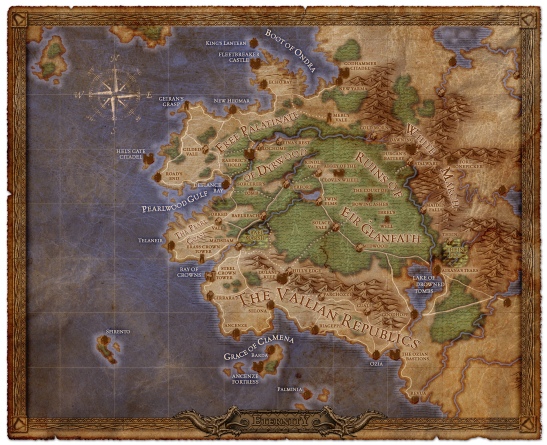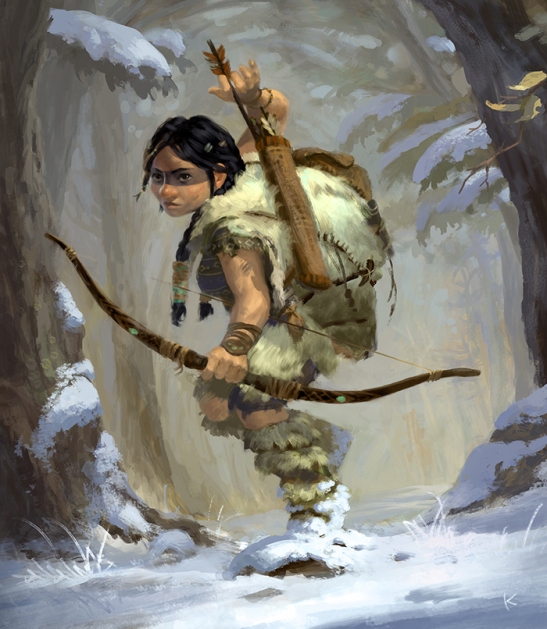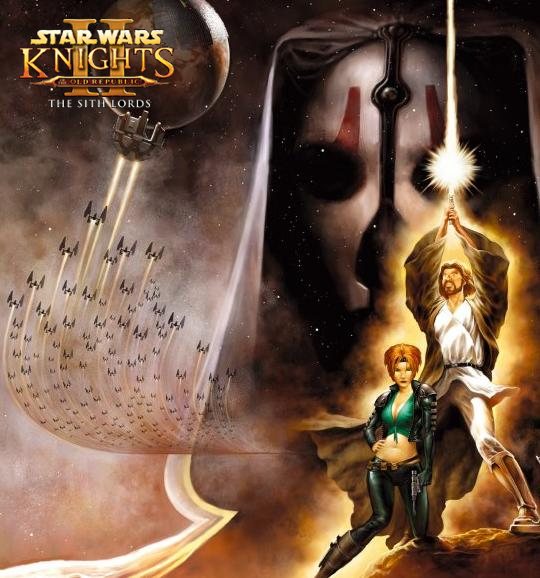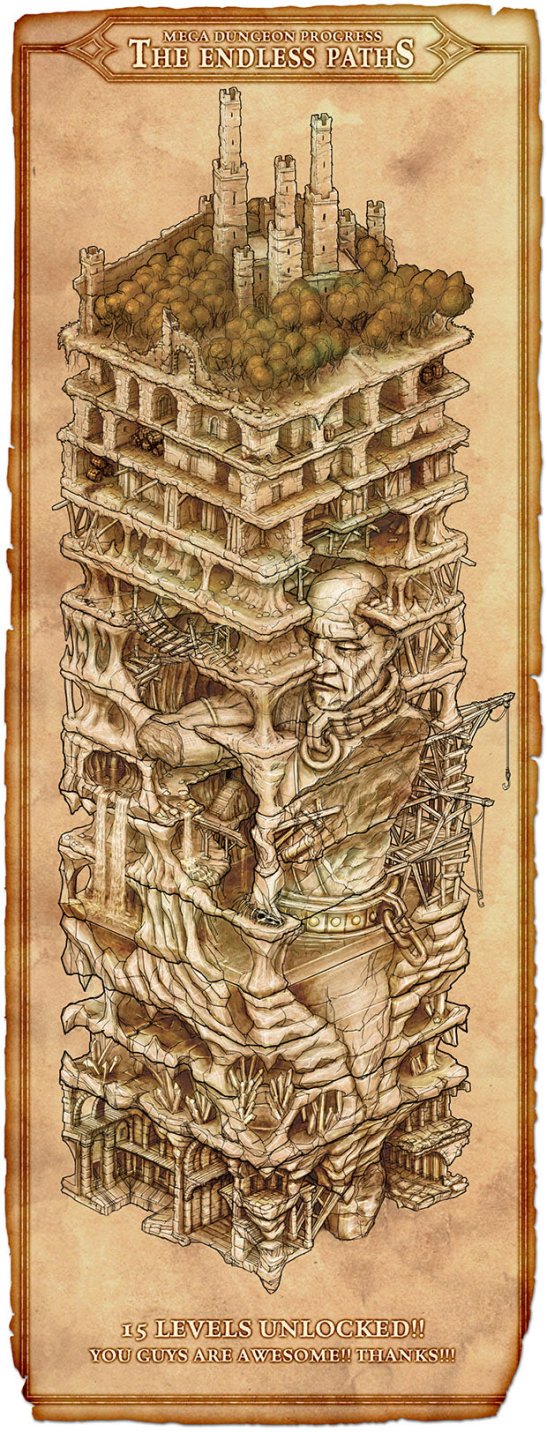Anon of Holland interviews Chris Avellone
As some of you who follow this blog might know, through the magic of the internet and Kickstarter I managed to meet, in person, the legendary Chris Avellone a few months ago (and if you didn’t know, you can read about that most wondrous of meetings here). Now, being the bumbling idiot that I become when I stand eye to eye with someone I admire, at the time I wasn’t able to ask him any of the questions that had been burning in my mind days before, so I thought my chance to get answers to them was forever lost. But, I thought, with Kickstarter being as amazing as it is – breathing new life into my favorite genre of games that I thought was dead forever and even allowing me to communicate with and actually meet the creative geniuses behind these games – that perhaps it could manage yet another miracle, so I took the chance of coming off as a rabid fanboy and asked Obsidian’s Social Media Manager if it would be possible to send Mr. Chris Avellone a list of questions that I had come up with. Amazingly, she told me she’d ask and he immediately agreed, so I happily sent in my questions and…here we are!
But, I thought, with Kickstarter being as amazing as it is – breathing new life into my favorite genre of games that I thought was dead forever and even allowing me to communicate with and actually meet the creative geniuses behind these games – that perhaps it could manage yet another miracle, so I took the chance of coming off as a rabid fanboy and asked Obsidian’s Social Media Manager if it would be possible to send Mr. Chris Avellone a list of questions that I had come up with. Amazingly, she told me she’d ask and he immediately agreed, so I happily sent in my questions and…here we are!
As you can probably tell from my question structuring, I’m no journalist, but I am a passionate video game enthusiast and I’m incredibly excited about Project: Eternity and Torment: Tides of Numenera, as well as Avellone’s and Obsidian’s previous work, so I tried to ask the things that, as a fan, were on my mind.
Hopefully you’ll enjoy reading MCA’s answers as much as I did.
AoH: One of the things at the top of fan’s lists of things they’d like to hear about would no doubt be Project: Eternity. So far we’ve been seeing a lot of tech and lore updates on the Kickstarter page and the forums, and although I’m sure I wasn’t the only one blown away by that amazing tech demo, it feels like the world design has been put on the back burner a bit, at least as far as the updates go. I understand Obsidian might not want to go into this as of yet in order to save information for future updates, but I was wondering if you could tell us a little about how well the world has been fleshed out so far, which direction it’s going in to make it different from all those cliché fantasy settings out there and what the plans are for the world as shown in the map? Will we be visiting locations all over the map or will you be focusing on a certain area, maybe leaving the other areas for another game?
MCA: It will be locations all over the map (to clarify, it’s the one below).
 [Project: Eternity’s Map – Graciously provided by Mr. Avellone in beautiful high resolution]
[Project: Eternity’s Map – Graciously provided by Mr. Avellone in beautiful high resolution]
The world map [above] is the game space: the game takes place largely in the Dyrwood and the Ruins of Eír Glanfath – while the exact locations are still to be revealed, you will be going to a variety of communities and cities in those areas all over the map, as well as a number of adventure locations. As far as variety goes, it’s much like Icewind Dale in terms of location ambiance and scope (it may seem like an odd example, but while set in the North, there was a lot of freedom in Icewind Dale in terms of looks and feel of each location). As locations and dungeons unlock, you’ll be able to jump to them and begin exploring.
You will not be going beyond the world map indicated in this first installment of the series. Right now, we’re focused on bringing this section to life. That doesn’t mean we’re ignoring the rest of the world (and in fact, the cultures and empires surrounding the Dyrwood are extremely important to current events) – we’re developing the world and the surrounding nations in tandem with religion, culture, and language.
There’s directives we try and operate from in terms of design of the game which hopefully should shed some light on the process. In terms of development of the narrative, we have a first draft of a story that we’re iterating on after feedback from the team – the draft we chose as the spine was a collaboration of two stories, one from George Ziets and the other from Eric Fenstermaker. There were elements from every story pitch that we liked a lot, and other elements that we felt could be developed more, or made more impactful for the player.
We haven’t revealed a ton on story yet, and it’s because the narrative is important to us, and we want to avoid spoilers. A significant amount of lore, maps, character naming, deities, language, notable antagonists and protagonists has been developed, but it is under the story umbrella, and we’re not prepared to reveal it at this time until we’re comfortable with it. Story’s not something we like to rush at the studio, and for this project, we don’t have to, which is a huge relief. So far it’s allowed a far more collaborative and iterative process – Eternity has been one of the few opportunities we’ve had at the studio where almost all the designers had a chance to do a pass of a story draft and then critique each other’s elements. It felt like a creative writing workshop, which was awesome.
So what makes it different from fantasy settings – there’s a few things, and I’ll try to point to some specific examples: so – we have dwarves. Our dwarves aren’t typical dwarves, however, and allow for variation that may be unusual at a glance – for example, when we showcased Sagani, it might have been unusual to see a bow-using dwarf from an Inuit-inspired culture, but that’s something that Eternity aspires to branch into and explore concepts of fantasy races that haven’t been touched on yet. In our latest update, we describe paladins, but in the context of Eternity, which means they are cause-focused, not necessarily morality-focused, and it gives additional insight on how that difference manifests itself through their abilities, which I feel is pretty damn cool. Also, I’d like to think that the decision to veer away from the 14th century style of fantasy vs. the 16th was a good one as well, and can make its presence felt from weapons the characters wield, the clothes they wear, to the everyday architecture of cities and towns.
 [Sagani the Dwarf – Artwork provided by Mr. Avellone]
[Sagani the Dwarf – Artwork provided by Mr. Avellone]
Lastly, in terms of defying clichés, the magic system of a world changes everything about its culture. Brandon Sanderson’s Mistborn, Pat Rothfuss’s Name of the Wind, David Farland’s Runelords… each change in a magic or metaphysic system sends out a ripple effect across cultures and characters and conflicts, which is a good thing. So when we agree upon the principle of souls as governing magic and the cycle of the world, that opened itself up to interesting character, culture, and technology opportunities that may not exist in other settings.
Also, we have invested a lot of energy in systems, and I feel it’s the right call. All the mechanisms for how the player communicates and interacts with the environment should be established first, including how the player talks with characters, how they move, how they fight… this may seem common sense, but launching into production without a finalized design on how the character’s movement set works and the interface components can be problematic, so we want to make sure we do this right.
As a simple example of the importance of this, if you attempted to design 30 levels in Super Mario Bros without knowing how high and long Mario can jump, it’s almost impossible to do correctly – and more importantly, you want to make sure the basic act of jumping in a Mario game is polished and fun naturally from a second to second experience. For us, comparable examples would be how fast a party can move, how fast to swing a sword, what the player’s camera view on the world will be, and more. From there, you want to go into systems that define the character and then systems that allow them to affect the world – like spells.
AoH: Another Project: Eternity related topic that seems to be on everyone’s mind is the Mega Dungeon. During the Kickstarter campaign we collectively brought the number of levels to a massive 15, which has me slightly worried it could end up turning into a Shin Megami Tensei-level chore to get through. So far this has also been the subject of very few updates, which I suppose is because Obsidian is still working out the details. Are you personally working on the dungeon as well, and if so, in what capacity? Should we expect the dungeon to be mainly a ‘hack and slash’ experience or will there be more to it like in the case of the Castoff’s Labyrinth in Torment: Tides of Numenera?
MCA: I am not personally working on the dungeon (we haven’t entered the design stage for it yet), and I couldn’t give you an exact breakdown of talking vs. fighting. That said, combat and combat resolution is a big part of Eternity, and while conversations and stealth can help set you up in a favorable position when hostilities erupt, talk-intensive encounters are likely to be left for communities, towns, and other areas where it makes more sense; it may be that Od Nua becomes one such location. In the current iteration of the story, the mega dungeon serves a key role and has a lot of interesting mechanics being kicked around for it that I think will be compelling.
But to make this question personal, I love level design. The last time I did area design for Wasteland 2, I enjoyed it, although we have level designers here that are more capable than I could aspire to be (Bobby Null and Jorge Salgado are currently tackling the Vertical Slice levels). Personally, I look at a level design such as Od Nua and see possibilities, not as a chore, and so do our level designers. If I asked someone to design 15 levels of archaic soul-lore-focused insanity and have fun with it… the results I imagine would be great, and it’s worked with our other projects where we’ve given the LDs such freedom ([Fallout: New Vegas DLC] Old World Blues).
AoH: Speaking of the mega dungeon; the idea behind it and a statement you made in an interview with gamesindustry.biz “Numenera is much more free flowing, much more story focused, and Eternity is stuff like dungeon exploration, party team, how do you approach a problem, how do you approach an encounter.” might lead some to believe that Project: Eternity might end up becoming the Icewind Dale to Torment: Tides of Numenera’s Planescape: Torment; more focused on combat and exploration than actual deep role playing. Is this what you are specifically aiming for, or are you trying to strike a balance between the two?
MCA: Numenera is planned to have much more story than Eternity at this stage because it has many more writers on it, and that’s one of the major pillars for any Torment game. That doesn’t imply that the Eternity story will be weak or that the Numenera levels and locations will suffer, it just means they are two different experiences. Eternity will still have a compelling, reactive plot, and while it features dungeon exploration and party tactics, the story is still an important part of the whole… just as dungeons and the party tactics will be important in Numenera as well.
In short, based on what I’ve seen and read, neither one will sacrifice what it means to be a role-playing game, which means having player agency and clear choices that matter. Player agency is important to all aspects of design in our studio, from the character development systems, to the level design, to the narrative branching.
For a specific writing example, our goal with companions, for example, is Planescape Torment-style companions (for both Numenera and Eternity) because we feel that the people that travel with you create the best opportunities for RPG sounding board and reactivity feedback.
AoH: While we are on the subject of Torment; fans were obviously extremely relieved when they heard you’d be working Torment: Tides of Numenera, but some people seem to be slightly worried about your seemingly rather small role in the creation of the game, where you were such a huge part of why the original Torment was so amazing. What can you tell us about that?
MCA: I talk to Kevin Saunders and Colin McComb quite frequently, and I feel both of them understand what made Torment what it was (and Colin has the added benefit of having done a large part of the design for the original as well and Kevin headed up Mask of the Betrayer, which I felt had a lot in common with the Torment approach). They’ve given me free access to almost all the design elements and I’ve been enjoying a great deal of the systems, mechanisms, and story hooks they’ve placed in the game. I also feel like Monte Cooke’s Numenera setting is pretty freeing as well for designers – you can do virtually anything in it, and the world lore is such that it can easily accommodate almost any idea or mechanic.
 [An example of a wonderous setting in the Numenera world: Torment’s Oasis of M’ra Jolios]
[An example of a wonderous setting in the Numenera world: Torment’s Oasis of M’ra Jolios]
AoH: Taking a step away from recent developments, what would you say is your favorite ‘modern’ (post-2005) Role-Playing Game and why? Which are your favorite ‘modern’ characters?
MCA: My evaluations are somewhat different than what people might expect, since I’m approaching it from a critique perspective, and looking at how elements were realized. I don’t play a lot of Japanese RPGs (this isn’t out of bias, it’s due to time), and I also don’t solely play RPGs (I try to branch out into other genres when possible to see how they solved some gameplay issues or how they realized their vision). One of my most recent favorite RPG in terms of design principles was Fallout 3, and aside from the sense of freedom and exploration reward, there was one other outstanding reason – they turned almost every obstacle and hazard into an opportunity for reward for the player, which I thought was great. Simple examples of this include the ability to pick up and use mines in the environment and the fact dead-ends often had containers and boxes in them embedded in the rubble – this sounds minor, but it’s a way of maximizing gameplay that I appreciate.
My favorite characters weren’t in RPGs, they were in other titles. In Saint’s Row III, I thought Zimos was amazing (plus the voice acting and filter as well – I would call him in just to hear him talking in battle), and the way [Telltale’s] The Walking Dead turned one of my habitually-hated stereotypes (escort quest and the escort is a kid – double hate) and made it compelling through execution.
AoH: Is there any one IP that holds a special place in your heart and that you would love to work on, given the chance?
Fallout’s always great. System Shock would be a fun one. There’s probably others out there, although those two are highest on my radar. I’m really looking forward to the Fables game by Telltale, they seem to have captured the look perfectly.
AoH: As someone who has been in the industry for such a long time, there must be many things you’ve done and were extremely proud of, and perhaps just as many things that you regret not getting exactly right or even screwing up completely; what are the first things you think of when you hear this?
MCA: I am proud that I still have time and make time to talk with and respond to aspiring game developers who wants advice or help. That would rarely happen while I was growing up, and I always appreciated the few people that took the time to give me pointers and help me reach my dream job.
I am also proud that I champion speech-related and talking-related pacifist solutions and freedom of character agency in RPGs I work on. I like it when you can join the bad guy, or tell him why his plan is screwed and have him give up or fall apart, and just prove that brains is a viable solution for some character builds.
I am proud of making a game ([Planescape:] Torment) that took everything I hated about RPGs and turned them around and lived to see it appreciated for what it was. On the converse, I am not proud of the fact that that may be the only message I have for the world before I’m out of here. ;)
Also, I’m not happy with scope evaluations of previous projects I’ve worked on, the last of which was Knights of the Old Republic II. We could have downscaled earlier and not pursued some story elements in that title (cut down the companions, removed the minigames, and recognized that cutscenes are difficult to do in the engine) and made a more complete version… I’ve worked hard to fix that in titles since, but KOTOR2 still stands out as a game that could have been much better than it was, and I am responsible for that.
 [KotOR II – A game that I personally loved from start to terribly rushed finish]
[KotOR II – A game that I personally loved from start to terribly rushed finish]
AoH: I’ve always wondered how you ended up writing for computer games (RPGs more specifically) in the first place. Did you ever consider perhaps writing a book, or even writing for games in other genres?
MCA: I always wanted to write comic books, and I’d still love to do that as well. I enjoyed the brief opportunities I had to do that for Star Wars. As it’s turned out, writing for video games has proven to be a gateway into novellas, more comics, and other types of writing relatively easily (and backer-financed). I never thought I’d get the chance to say I’d be writing a Wasteland 2 novella, a Torment comic, and an Eternity novella all in the same year, and I’m really enjoying the process so far, I feel like it’s allowed me to shift gears and approach storytelling a little differently than I’m used to, but still in a way that complements the game narrative.
AoH: For my last question I’d like to take a look at the future; the new console generation is coming, games are becoming more and more mainstream and budgets are rising to ludicrous levels. Where do you see Obsidian in all of this?
MCA: I think we’ll still pursue a variety of projects. My hope (and it seems to be proving itself out), is that once the viability of smaller budget “hardcore” PC RPGs is proved out via Kickstarter that other publishers will see it as an opportunity to get into the same space and be more willing to finance a smaller project. Doing several Eternity-sized projects at once for Obsidian would be a nice nostalgic return to the Black Isle days for me at least, and it’s a direction that inXile seems to already be going in with Wasteland 2 and Torment: Tides of Numenera. I’d rather get the funding through Kickstarter if possible, but if we find the right publisher and it’s a good fit, great.
AoH: As a sort of Bonus Question, I wonder what your opinion is on the Netherlands now that you’ve spent a few days here? I wanted to ask you this in Amsterdam but didn’t think of it at the time. Did you stay long or were you on your way somewhere else? Is there anything you ate, saw, tried or experienced that was memorable to you?
MCA: I loved the Netherlands, I loved walking the canals (I loved that I could walk almost anywhere, which was a huge plus after California), I loved the architecture and layout, and everyone was really nice during the visit… the local game devs were more than happy to show me around, introduce me to good food places, and we all sat around and talked about games for hours. I also got to meet Brother None, Thomas Beekers, who I only knew via the internet and now works at inXile. Overall, was a great visit – the two days I spent doing a walking tour of Jordaan and the Old Center and checking out the Rembrandt exhibit at the Rijksmuseum was amazing (along with going to a downtown nightclub that played 8-bit electronic music, which was also tremendous fun). You all took very good care of me, I’d love to come back!
By the way, be sure to check out Avellone’s 45 minute talk on Project: Eternity at Rezzed in the UK this week.


Cool beans
“One of my most recent favorite RPG in terms of design principles was Fallout 3…”
NMA explodes. I don’t though, I love Fallout 3 as well as the first two and New Vegas. NV is probably my fav.
I liked your non-journalistic interview very much :)
And I’m really afraid that this megadungeon will become some kind of Diablo minigame :/
Thanks!
I have to admit that was also what I was worried about, but reading Chris’ answer, I think there’s definitely room to do something awesome with it such as they’re doing with the Castoff’s Labyrinth in Torment. As long as they don’t just make us grind level after level of enemies (which it looks like they won’t be doing) I think there’s actually a lot of potential.
Yes, the answer was somewhat comforting in that regard. In any case I think it’s good you asked because they apparently didn’t do much on the mega dungeon front yet so the more they keep in mind during writing and development that this is a concern for people, the better the chances are that it will actually be avoided.
Pingback: Ex-Interplay Fridays
Pingback: The Kickstarter round up | Anonymous of Holland - Gaming, Movies and Complaints
Pingback: Nowa mapa świata Project Eternity - Pillars of Eternity POLSKA